July 18-25, 2001
The Big Travelogue: Part One
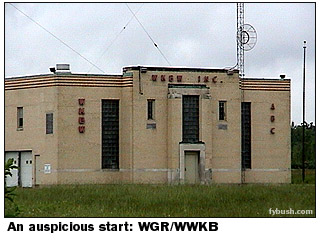 There's
nothing like a good road trip to get a feel for the state of
radio these days. From June 23 until July 7, your editor (accompanied
by Boston Radio Archives creator Garrett Wollman) hit the road
to see what's on - and in - the air across a broad swath of mid-America. There's
nothing like a good road trip to get a feel for the state of
radio these days. From June 23 until July 7, your editor (accompanied
by Boston Radio Archives creator Garrett Wollman) hit the road
to see what's on - and in - the air across a broad swath of mid-America.
For the next few installments of Site of the Week, we'll be
recapping the many highlights of what we like to think of as
The Big Trip, 2001 edition. Come along...
Friday, June 22 - Call it the "pre-show"
if you will, as Garrett travels from his home near Boston to
NERW Central in Rochester, stopping off at several sites we've
already documented here on Site of the Week (Smith Hill in Utica)
and a few that are due for SotW treatment soon (Sentinel Heights
in Syracuse, WSYR and WHEN).
Pulling into Greater Rochester in the late afternoon, we meet
in Perinton to show Garrett some of the Rochester-area sites
he hasn't seen: the new WVOR/WNVE antenna atop Baker Hill, the
WBEE-FM (and, someday, WBBF-FM) tower in Penfield and the AM
sites in Brighton. A send-off dinner with other local radio fans
follows, and then a good night's sleep to prepare for the long
road ahead.
Saturday, June 23 - On the road, traversing US 20A
through Wyoming County (a new one for Garrett, and we're counting
on this trip) en route to the southern suburbs of Buffalo. The
plates on the rental car read "3232 KB," and that's
all the excuse we need to take Garrett to "KB."
The picture at the top of the page tells the story: this six-tower
site on Big Tree Road in Hamburg is the old WKBW, now WWKB, and
once again co-owned with WGR (550), its diplex partner at the
site. Note the old lettering on the building: "WKBW INC."
and "ABC"!
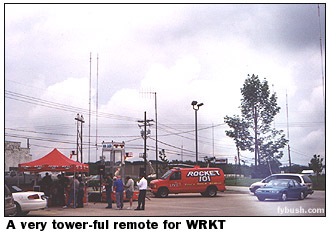 Another
stop at the WNED (970) five-tower array down the road, now with
WHLD (1270 Niagara Falls) diplexing, and we're off to Erie for
wings and an impromptu stop at a WRKT (100.9) remote, ironically
enough within sight of the big TV towers just down Peach Street. Another
stop at the WNED (970) five-tower array down the road, now with
WHLD (1270 Niagara Falls) diplexing, and we're off to Erie for
wings and an impromptu stop at a WRKT (100.9) remote, ironically
enough within sight of the big TV towers just down Peach Street.
(That's WQLN-TV/FM and WFXP on the left side of the picture,
WSEE-TV near the right, and WJET-TV just on the right edge of
the frame...)
Cleveland, a couple of hours later, finds us parked outside
a fast-food place taping a whole slew of legal IDs in preparation
for the big changes we know are coming in a week's time. This
is our last chance to hear classical WCLV (95.5) on that big
signal - it's selling its facility to Salem, which will flip
it to "Fish" WFHM. In the process, Clear Channel will
get Salem's 98.1 in Canton (WHK-FM), move its CHR WKDD there
from 96.5 Akron, and move its CHR "Kiss" WAKS to 96.5
from 104.9 out west in Lorain. WCLV will then end up on 104.9.
But wait - there's more! WCLV will also get the AM 1420 signal
that's now doing religious talk for Salem as "WHK."
That format will move to what's now all-sports WKNR (1220), while
WKNR's sports talk will move to what's now standards WRMR (850).
But to keep the WHK three-letter call from disappearing, Salem
has temporarily moved it to AM 1000 in Parma, ex-WCCD. So "WCCD"
on 1000 is slipping a "WHK Parma-Cleveland" legal in
every hour, while 1420 is legally WHKK for the moment.
Tape having been rolled and the "before" calls documented,
it's off to the Ohio Turnpike (who was James Shocknessy,
anyway?) and across the Indiana border to our overnight stop
in Fort Wayne (with a couple of quick station tours first...)
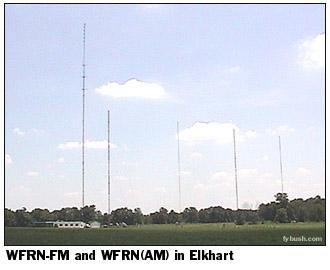 Sunday, June 24
- We leave Fort Wayne by way of Roanoke and the WOWO site
(which we'll visit for a Site of the Week of its own sometime
this fall). An hour or so away is Goshen and WKAM (1460), with
two towers, and then Elkhart just up the road. Sunday, June 24
- We leave Fort Wayne by way of Roanoke and the WOWO site
(which we'll visit for a Site of the Week of its own sometime
this fall). An hour or so away is Goshen and WKAM (1460), with
two towers, and then Elkhart just up the road.
South of Elkhart are the studios of Fox 28, WSJV-TV (formerly
an ABC affiliate), and around the corner, the four AM towers
and big FM tower of religious WFRN ("Your Friend.")
Another twenty minutes or so of driving and we're in the southern
outskirts of South Bend, beginning our tower hunt with religious
WHME-TV (Channel 46). From there, we look to the west to see
another cluster of tall towers: most of the TV in the market.
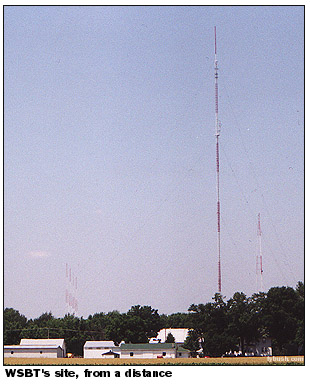 Two
adjacent towers carry the signals of WSJV, PBS outlet WNIT (Channel
34), ABC low-power WBND-LP (Channel 58), its WB counterpart on
channel 69, and NPR outlet WVPE (88.1). Two
adjacent towers carry the signals of WSJV, PBS outlet WNIT (Channel
34), ABC low-power WBND-LP (Channel 58), its WB counterpart on
channel 69, and NPR outlet WVPE (88.1).
A couple of miles away on Ironwood Road is the big grouping
of towers. Look at the photo to the right: it contains pretty
much every type of broadcast tower to be found by the average
tower-hunter. On the left (the west side), we see the four towers
WSBT (960) uses for its night pattern. In the middle, the tall
tower carries CBS affiliate WSBT-TV (Channel 22), its DTV counterpart,
and its FM sister, WNSN (101.5).
On the right: the self-supporter that's part of the daytime
array for WSBT(AM) and also carries the original WSBT-TV antenna
from its early days on channel 34. (Every South Bend TV station
has changed channels at least once, it seems...)
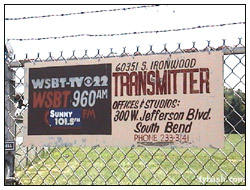 You
can't fault the signage here: there's no doubt whatsoever about
where we're standing, what it is, and who to contact if there's
any problem with it. You
can't fault the signage here: there's no doubt whatsoever about
where we're standing, what it is, and who to contact if there's
any problem with it.
You also can't fault the building itself, seen below: a beautiful
example of the classic Art Deco Transmitter style.
It looks big enough to accomodate a studio, though there's
none here; just down Ironwood, though, is the studio of Lester
Sumrall's LeSea Broadcasting group of stations: WHME -TV, WHME-FM,
WGTC-FM and shortwave WHRI, part of his World Harvest Ministries
group of shortwave outlets around the world.
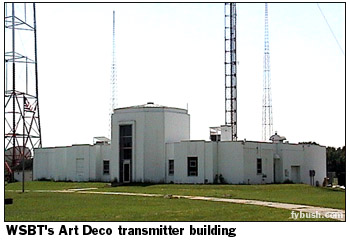 And as we're admiring
all this transmitter glory, the phone rings and we finally make
contact with the chief engineer of WNDU-TV (Channel 16), George
Molnar. And as we're admiring
all this transmitter glory, the phone rings and we finally make
contact with the chief engineer of WNDU-TV (Channel 16), George
Molnar.
George offers to come down and show off his facility, and
we're glad to wait around for a few minutes for the privilege.
WNDU's calls stand for "Notre Dame University,"
which has owned the station since its inception in the fifties.
And while its transmitter has always been on Ironwood Road, everything
else about the station has changed dramatically.
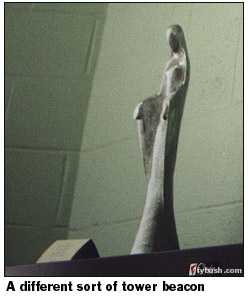 Well,
nearly everything - the statue you see at the left is a plaster
replica of the cast-aluminum statue of Our Lady Notre Dame that
was first placed atop the original WNDU-TV tower when it signed
on. Well,
nearly everything - the statue you see at the left is a plaster
replica of the cast-aluminum statue of Our Lady Notre Dame that
was first placed atop the original WNDU-TV tower when it signed
on.
George tells us Father Edmund P. Joyce, the executive vice
president of the university, climbed up the 500-foot tower to
bless the statue when it first went up there in July 1955. When
the new, taller tower went up in 1969, the statue was brought
down to the base for Father Joyce to bless (he was then 54),
and when the statue was repaired and plated in 1993, George took
it to Father Joyce in his campus office for another blessing!
WNDU recently completed a massive renovation of its site,
linking its original 1955 transmitter building, at the base of
the original tower, with the 1960s-vintage building at the base
of the newer tower.
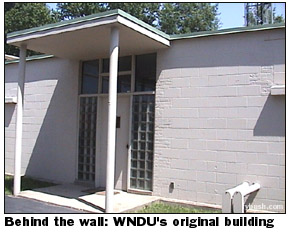 The
new design put a wall around the two older buildings and a new
transmitter building between them, providing plenty of room for
WNDU's conversion to digital television. The
new design put a wall around the two older buildings and a new
transmitter building between them, providing plenty of room for
WNDU's conversion to digital television.
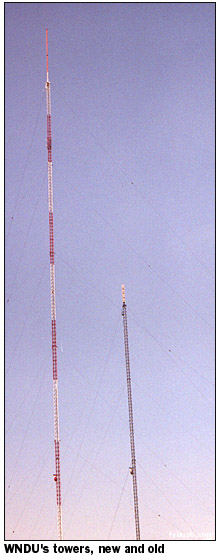 WNDU
was an early DTV convert, one of the smallest-market stations
to make its move so quickly, and that extra older tower came
in handy. The original WNDU-TV antenna came down, and in its
place went a broadband antenna that can serve both as a backup
for channel 16 NTSC and as a primary for WNDU-DT, channel 42.
(It's actually even more broadband than that; it was designed
for WNDU-DT's original allocation on channel 65!) WNDU
was an early DTV convert, one of the smallest-market stations
to make its move so quickly, and that extra older tower came
in handy. The original WNDU-TV antenna came down, and in its
place went a broadband antenna that can serve both as a backup
for channel 16 NTSC and as a primary for WNDU-DT, channel 42.
(It's actually even more broadband than that; it was designed
for WNDU-DT's original allocation on channel 65!)
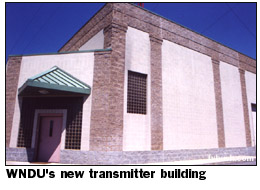 With
the new antenna came a new Comark digital transmitter, with four
modules that can each handle NTSC or DTV. At the moment, three
of the modules handle channel 16 duties, with the other one being
used for WNDU-DT. When it comes time to maximize the DTV signal,
the "borrowed" module will be returned from analog
use to digital. With
the new antenna came a new Comark digital transmitter, with four
modules that can each handle NTSC or DTV. At the moment, three
of the modules handle channel 16 duties, with the other one being
used for WNDU-DT. When it comes time to maximize the DTV signal,
the "borrowed" module will be returned from analog
use to digital.
Meanwhile, WNDU's site is home to two more stations. In the
1969-vintage building, along with a backup WNDU-TV transmitter
and an old RCA transmitter that's on the verge of being dismantled,
sits the transmitter for the former WNDU-FM (92.9). Notre Dame
sold its radio operations a couple of years ago, and "U93"
kept its name and CHR format but changed calls to WNDV-FM. (Its
AM outlet on 1490 simulcasts, also as WNDV, with a self-supporting
tower within sight of Notre Dame's football stadium.)
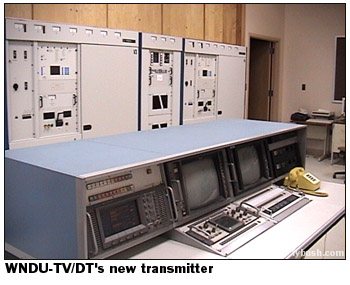 In
the back building, George shows us the room where WNDV-FM's new
transmitter will soon be installed, along with the ancient FM
transmitter that was the first WNDU-FM unit decades ago. In
the back building, George shows us the room where WNDV-FM's new
transmitter will soon be installed, along with the ancient FM
transmitter that was the first WNDU-FM unit decades ago.
This building is also home to WSND-FM (88.9), the classical
station that's operated by Notre Dame students, as well as an
FBI two-way transmitter.
There's still more to see here - a hefty generator setup,
a huge new garage where WNDU can work on its satellite trucks
in the winter without braving the elements, and that old tower
beacon mounted on a three-foot tower inside the front door (it
works!) But downtown South Bend calls (as does lunch), so we
head off to see WSBT's studios (across the street from parent
South Bend Tribune), little noncomm WUBS (89.7), and the
WNDU studio complex at the edge of the Notre Dame Campus.
Michigan lies just a few miles to the north, and we obligingly
cross the line to see Niles and WNIL (1290) and WAOR (95.3).
 And from there, we
begin our assault on the Windy City. And from there, we
begin our assault on the Windy City.
I-80 is choked with traffic, so we detour through downtown
Gary, Indiana to reach the four towers at the bottom of Chicago's
AM dial.
WIND (560) isn't named for the "WINDy City," you
know; its calls stem from "INDiana," where it was first
licensed and where its transmitter still sits.
What you see here is about as much as we were able to see;
a busy rail line sits between the nearest public road and the
site itself. Look very carefully here and you can just make out
the capacitance hats that crown each of the four towers at the
WIND site. The transmitter building and an STL tower sit out
of frame to the left.
An hour later, and some Sunday-evening traffic, and we've
arrived in downtown Chicago for dinner.
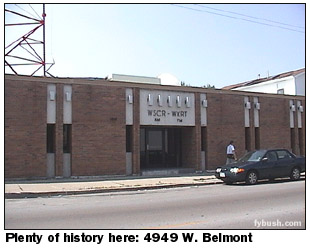 Monday,
June 24 - If the game is "Tower Hunters vs. Chicago,"
we're winning. Traffic is surprisingly light as we wind our way
through the streets of the North Side, admiring the 60s-vintage
studios of WGN-TV, then moving over to West Belmont Avenue for
a brush with radio history. Monday,
June 24 - If the game is "Tower Hunters vs. Chicago,"
we're winning. Traffic is surprisingly light as we wind our way
through the streets of the North Side, admiring the 60s-vintage
studios of WGN-TV, then moving over to West Belmont Avenue for
a brush with radio history.
The 1240 kHz frequency in Chicago was one of the last share-time
operations in the country, with ethnic stations WSBC, WCRW and
WEDC each trading off short airshifts during the course of a
day. 4949 W. Belmont was the home of WSBC's studios and antenna,
as well as its FM sister, WXRT (93.1).
Much has changed here in recent years: WSBC consolidated its
hold on 1240 by purchasing WEDC, which had itself bought WCRW
a few years earlier. Diamond Broadcasting, which owned WSBC and
WXRT, added a third station when it bought then-silent AM 820
in the late eighties, turning it into WSCR, "The Score."
(In the process, 820 having lost its old night site out in the
suburbs, that facility became a daytimer, diplexed off the WSBC
tower on Belmont.) Infinity then bought Diamond, moving WSCR
to the 1160 facility that used to be WJJD and selling off the
820 and 1240 licenses.
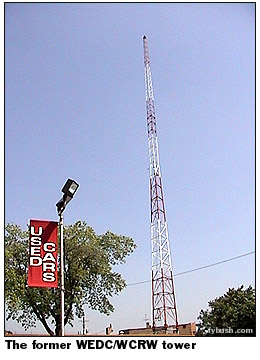 And then, of course,
Infinity killed off what was left of WMAQ radio and moved WSCR
one last time last summer, placing it on WMAQ's old 670 kHz signal
with a mighty 50 kW signal that would remain audible for almost
our entire trip. And then, of course,
Infinity killed off what was left of WMAQ radio and moved WSCR
one last time last summer, placing it on WMAQ's old 670 kHz signal
with a mighty 50 kW signal that would remain audible for almost
our entire trip.
We hear that WSCR's studios will eventually move from Belmont
downtown to the NBC Tower digs that WMAQ used to occupy, but
for now the Score still sits in the old WSBC facility - apparently
with a good view of the street, since one of the Score producers
comes outside to say hello when he sees us taking pictures!
(One more irony: that 820 facility, still transmitting from
the Belmont tower, is today WCSN, the Chicago home of Score competitor
Sporting News Radio!)
A few blocks away on Milwaukee Avenue, we see the earthly
remains of the other 1240 signals. WEDC's tudios were here, and
both it and WCRW used this tower, which still stands next to
a used-car lot. Will it ever be used for anything else? We don't
know...
From here, it's off to the suburbs and a face-to-steel encounter
with Chicago's big AM signals. Join us in this space next week
for Part Two, as we visit WGN, WBBM, WLS and more...
|
